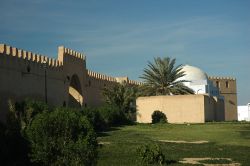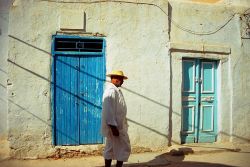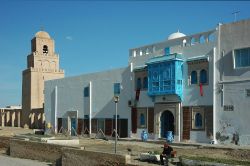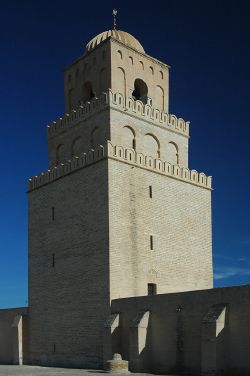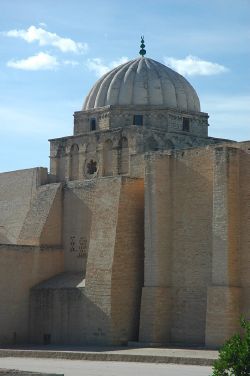Difference between revisions of "Kairouan" - New World Encyclopedia
Mike Butler (talk | contribs) |
Mike Butler (talk | contribs) |
||
| Line 105: | Line 105: | ||
==Looking to the future== | ==Looking to the future== | ||
| − | + | Kairouan dazzled the world 1200 years ago with wealth comparable to that of [[Basra]] and [[Kufa]], and as a centre of Islamic thought and secular science. A little under 1000 years ago, a split within Islam led to the destruction of that once glorious city. Declared a World Heritage Site in 1988, tourism, the establishment of another university there in 2004, plus the establishment of light industry, has helped revive the city's economy. | |
| − | + | While Tunisia struggles to reach even higher growth levels to create sufficient employment for an already large number of unemployed as well as the growing population of university graduates, Kairouan's old buildings continue to attract a steady flow of international visitors each year, which is a goldmine for the city's economy. | |
| − | |||
| − | |||
| − | |||
| − | |||
| − | |||
| − | |||
| − | |||
| − | |||
| − | |||
| − | |||
==Footnotes== | ==Footnotes== | ||
Revision as of 08:04, 8 December 2008
| Kairouan* | |
|---|---|
| UNESCO World Heritage Site | |
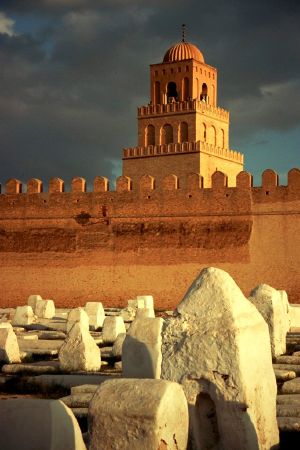
| |
| State Party | |
| Type | Cultural |
| Criteria | i, ii, iii, v, vi |
| Reference | 499 |
| Region** | Arab States |
| Inscription history | |
| Inscription | 1988 (12th Session) |
| * Name as inscribed on World Heritage List. ** Region as classified by UNESCO. | |
Kairouan (Arabic القيروان) (also known as Kirwan, and Al Qayrawan) is a Muslim holy city which ranks after Mecca and Medina as a place of pilgrimage,[1] particularly for sufis.[citation needed]
Founded in 670, Kairouan's Great Mosque and university made the city a center of Islamic thought by the ninth century, although the city was destroyed in the middle of the 11th century, making it an isolated market town for nomads.
Declared a World Heritage Site in 1988, tourism, the establishment of a university there in 2004, plus the establishment of light industry, has helped revive the city's economy.
Geography
The original name was derived from the Arabic word kairuwân, meaning "camp", "caravan", or "resting place".
Kairouan is located on the Low Steppes area of Tunisia, a semi-arid alluvial plain southeast of the Central Tell, about 100 miles (160km) south of Tunis, at an elevation of 223 feet (68 meters).
Kairouan has a semi-arid Mediterranean climate, with hot summers and mild winters, when there is more rainfall. Best periods are spring and autumn. The average maximum daytime temperature in January is 63.5°F (17.5°C), rising to an average maximum of around 99.5°F (37.5°C) in July. Mean annual precipitation is 12.1 inches (309mm).
Environmental issues include health risks posed by ineffective toxic and hazardous waste disposal, water pollution from raw sewage, and limited natural fresh water.
To protect Kairouan city against flooding from Wadi Merguellil, the El Haouareb dam was constructed in 1989.
History
Kairouan was founded in 670, when the Arab Umayyad general Uqba ibn Nafi (622–683) selected a site in the middle of a dense forest, then full of wild beasts and reptiles, as a base for military operations, and far enough from the sea where it was safe from continued attacks of the Berbers who had fiercely resisted the Arab invasion.
In 745 Kharijite Berbers captured Kairouan, which was by that time a developed city with luxuriant gardens and olive groves.
Power struggles continued until Ibrahim ibn al-Aghlab (756-812) recaptured Kairouan at the end of the eighth century. In 800, Ibrahim was confirmed Emir and hereditary ruler of Ifriqiya, the area comprising the coastal regions of what became western Libya, Tunisia, and eastern Algeria, by the Caliph in Baghdad. His Aghlabite dynasty ruled Ifriqiya between 800 and 909. Kairouan prospered, with wealth comparable to that of Basra and Kufa, giving Tunisia one of its golden ages.
The Aghlabites built the great mosque and established in it a university that was a centre of Islamic thought and secular sciences, attracting scholars from all over the Islamic World, including Imam Sahnun (776–854), and Asad ibn al-Furat (759-828). The Aghlabites built palaces, fortifications, and fine waterworks, and conquered Sicily in 827.
The Aghlabid emirs had personal and political excesses, prompting the emergence of the Maliki school, which is is one of the four schools of religious law within Sunni Islam.
In 893, Kutama Berbers from the west of the country started the Shiite Fatimid movement, which in 909 overthrew the Sunni Aghlabites, creating the Shiite Fatimid dynasty. Kairouan was neglected as the new rulers resided first in Raqqada but soon moved their capital to the newly built Al Mahdiyah on the coast of modern Tunisia.
The Fatimids extended their rule over all of central Maghreb, an area including modern Morocco, Algeria, Tunisia and Libya, and moved west to Egypt to found Cairo, making it the capital of their vast Califate, and leaving the Zirids, a Kutama Berber dynasty, as their vassals in Ifriqiya.
Governing again from Kairouan, the Zirids led the country through another artistic, commercial and agricultural heyday. Schools and universities flourished, overseas trade in local manufactures and farm produce ran high, and [Zirid]] courts were centers of refinement eclipsing those of their European contemporaries.
When the Zirids declared their independence from Cairo and their conversion to Sunni Islam in 1045, by giving allegiance to Baghdad, the Fatimid Caliph Ma'ad al-Mustansir Billah (1029–1094) sent hordes of Arab tribes (Banu Hilal and Banu Sulaym) to invade Ifriqiya.
By 1057, Kairouan was destroyed, and nomadism spread in areas where agriculture had been dominant. With the rise of Tunis as capital, Kairouan declined into an isolated market town for nomads.
In 1159, Tunisia was conquered by the Almohads, caliphs of Morocco (1130–1269), who sought to purify Islamic doctrines.
The Almohad Dynasty was succeeded by the Hafsids Dynasty (c.1230–1574), under whom Tunisia prospered. In the last years of the Hafsids, Spain seized many of the coastal cities, but these were recovered for Islam by the Ottoman Empire. The Ottoman Empire was comprised mostly of Turks with governors or Beys, under whom Tunisia attained virtual independence.
In the late sixteenth century, the coast became a pirate stronghold. The piracy carried on thereafter by the Muslims of North Africa began as part of the wars against Spain. In the seventeenth and eighteenth centuries, when the Turkish hold on the area grew weaker, the plunder, ransom, and slaves that resulted from attacks on Mediterranean towns and shipping and from occasional forays into the Atlantic became the main source of revenue for local Muslim rulers.
In the spring of 1881, France invaded Tunisia, claiming that Tunisian troops had crossed the border to Algeria, France's main colony in Northern Africa. The French, controlled Kairouan until 1956, having established a protectorate system of administration that recognized the nominal authority of local government.
Violent resistance to French rule boiled up in 1954. Independence from France was achieved on March 20, 1956, as a constitutional monarchy with the Bey of Tunis, Muhammad VIII al-Amin Bey, taking the title King of Tunisia.
In 1957, Habib Bourguiba (1903–2000) became prime minister, immediately abolishing the monarchy, and establishing a strict state under the Neo-Destour (New Constitution) party. He dominated the country for 31 years, repressing Islamic fundamentalism and establishing rights for women unmatched by any other Arab nation.
Government
Tunisia is a republic in which the president, who is chief of state, is elected by popular vote for a five-year term, and has no term limits. The prime minister, who is head of government, is appointed by the president. There is Chamber of Deputies, or Majlis al-Nuwaab, comprising 189 members elected by popular vote to serve five-year terms, and the Chamber of Advisors, comprising 126 seats of which 85 members are elected by municipal counselors, deputies, mayors, professional associations and trade unions, and 41 members are presidential appointees.
Kairouan is the capital of the Kairouan Governorate, which is one of Tunisia's 24 governorates, and which are divided into 262 districts (mutamadiyat), and further subdivided into delegations. There are 11 delegations in Kairouan, which are further divided into municipalities.
Economy
Tourism has made an impact on Kairouan since it was declared a World Heritage Site in 1988, most notably by providing a reason for the conservation of the old city and the development of the town’s Musée d’Art Islamique. According to statistics released in December 2008, Tunisia hosted, during the first 11 months of 2008, around 6.6 million tourists, an increase of 3.7 percent on the previous year.
The establishment of a university in 2004, and of some light industry meant the town has expanded quickly.
Otherwise, the modern city trades in grain and livestock from the surrounding region, and exists as a center for carpet and handicrafts. A road and railway link Kairouan with Sousse, 38 miles (61km) to the east.
Demographics
Kairouan had about 150,000 inhabitants in 2003. Ninety eight percent of Tunisia's population were Arab, one percent were European, while Jewish and others totalled one percent. Arabic is the official language, and one of the languages of commerce, while French is used in commerce.
Muslims make up 98 percent of the population, Christians one percent, Jewish and other one percent. There are numerous mosques in Kairouan, including the great mosque. Judaism featured in Kairouan's history, particularly in the early Middle Ages. Rabbeinu Chananel (990-1053), who is best known for his commentary on the Talmud, was from Kairouan.
Kairouan university had more than 3000 students enrolled in 2008.
Of interest
The Mosque of Uqba, also known as the Great Mosque of Kairouan, which has a 115-foot- (35-meter) high minaret, is one of the most important mosques in Tunisia. Built by Uqba ibn Nafi from 670 C.E., at the founding of the city of Kairouan, the mosque has an area of 900 square metres and is considered as a model for all later mosques in the Maghreb. There are 414 columns in the mosque, almost all of which were taken from the ruins of Carthage. Previously, it was forbidden to count them, on pain of blinding. Other sites of interest include:
- The souk (market place) of Kairouan in the Medina quarter, which is surrounded by walls, from which the entrance gates can be seen in the distance. Products sold there include carpets, vases, and leather goods. Merchants rely on tourists for much of their income.
- The seat of the religious fraternity of Sīdī Sahab, which contains the tomb of one of the companions of Muhammad, is located near the town.
- An Aghlabid reservoir, an open circular pool 420 feet (128 metres) in diameter, which dates from the ninth century.
Kairouan is known for its pastries — zlebia and makroudh. In the action movie Raiders of the Lost Ark, the street scenes in "Cairo" were filmed in Kairouan.
Looking to the future
Kairouan dazzled the world 1200 years ago with wealth comparable to that of Basra and Kufa, and as a centre of Islamic thought and secular science. A little under 1000 years ago, a split within Islam led to the destruction of that once glorious city. Declared a World Heritage Site in 1988, tourism, the establishment of another university there in 2004, plus the establishment of light industry, has helped revive the city's economy.
While Tunisia struggles to reach even higher growth levels to create sufficient employment for an already large number of unemployed as well as the growing population of university graduates, Kairouan's old buildings continue to attract a steady flow of international visitors each year, which is a goldmine for the city's economy.
Footnotes
- ↑ (1996) Hutchinson Encyclopedia 1996 Edition. Helicon Publishing Ltd, Oxford, pg.572. ISBN 1-85986-107-5.
Further reading
- Armes, William Dallam. 1915. The African Mecca; the holy city of Kairouan. Berkeley: University of California Press. OCLC 30001203
- Maoudoud, Khaled. 1992. Kairouan: history of the city and its monuments. [Tunis]: National Heritage Agency. ISBN 9789973917065
- Office national du tourisme tunisien. 1984. Tunisia: Kairouan. Tunis?: Tunisian National Tourist Office. OCLC 55479562
- Petrie, Graham. 1908. Tunis, Kairouan & Carthage. London: W. Heinemann. OCLC 412710
- Sebag, Paul, and André Martin. 1965. The Great Mosque of Kairouan. London: Collier-Macmillan. OCLC 1122988
External links
- World Fact Book 2008 Tunisia Retrieved December 4, 2008.
- LookLex Tunisia: Kairouan Retrieved December 7, 2008.
- Kairouan official website Retrieved December 8, 2008.
- Tourismtunisia.com Kairouan Retrieved December 8, 2008.
- Kairouan World heritage Site, whc.unesco.org, retrieved December 8, 2008.
- Kairouan University Retrieved December 8, 2008.
- Tunisia.com Retrieved December 8, 2008.
- Al-Qayrawan, MuslimHeritage.com, retrieved December 8, 2008.
- Kairwan, JewishEncyclopedia.com, retrieved December 8, 2008.
- Tunisia WorldStatesmen.org, retrieved December 8, 2008.
Credits
New World Encyclopedia writers and editors rewrote and completed the Wikipedia article in accordance with New World Encyclopedia standards. This article abides by terms of the Creative Commons CC-by-sa 3.0 License (CC-by-sa), which may be used and disseminated with proper attribution. Credit is due under the terms of this license that can reference both the New World Encyclopedia contributors and the selfless volunteer contributors of the Wikimedia Foundation. To cite this article click here for a list of acceptable citing formats.The history of earlier contributions by wikipedians is accessible to researchers here:
The history of this article since it was imported to New World Encyclopedia:
Note: Some restrictions may apply to use of individual images which are separately licensed.
